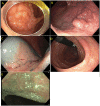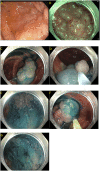Endoscopic Management of Complex Colorectal Polyps: Current Insights and Future Trends
- PMID: 35127735
- PMCID: PMC8811151
- DOI: 10.3389/fmed.2021.728704
Endoscopic Management of Complex Colorectal Polyps: Current Insights and Future Trends
Abstract
Most colorectal cancers arise from adenomatous polyps and sessile serrated lesions. Screening colonoscopy and therapeutic polypectomy can potentially reduce colorectal cancer burden by early detection and removal of these polyps, thus decreasing colorectal cancer incidence and mortality. Most endoscopists are skilled in detecting and removing the vast majority of polyps endoscopically during a routine colonoscopy. Polyps can be considered "complex" based on size, location, morphology, underlying scar tissue, which are not amenable to removal by conventional endoscopic polypectomy techniques. They are technically more challenging to resect and carry an increased risk of complications. Most of these polyps were used to be managed by surgical intervention in the past. Rapid advancement in endoscopic resection techniques has led to a decreasing role of surgery in managing these complex polyps. These endoscopic resection techniques do require an expert in the field and advanced equipment to perform the procedure. In this review, we discuss various advanced endoscopic techniques for the management of complex polyps.
Keywords: colonoscopy; colorectal cancer; colorectal polyp; endoscopic mucosal resection; endoscopic submucosal dissection.
Copyright © 2022 Mann, Gajendran, Umapathy, Perisetti, Goyal, Saligram and Echavarria.
Conflict of interest statement
The authors declare that the research was conducted in the absence of any commercial or financial relationships that could be construed as a potential conflict of interest.
Figures









References
-
- CDC. Colorectal (Colon) Cancer. CDC (2020). Available online at: https://www.cdc.gov/cancer/colorectal/statistics/index.htm (accessed February 15, 2021).
-
- Cancer, Research UK . Bowel Cancer Statistics. Cancer Research UK. Available online at: https://www.cancerresearchuk.org/health-professional/cancer-statistics/s... (accessed February 15, 2021).
Publication types
LinkOut - more resources
Full Text Sources
Miscellaneous

